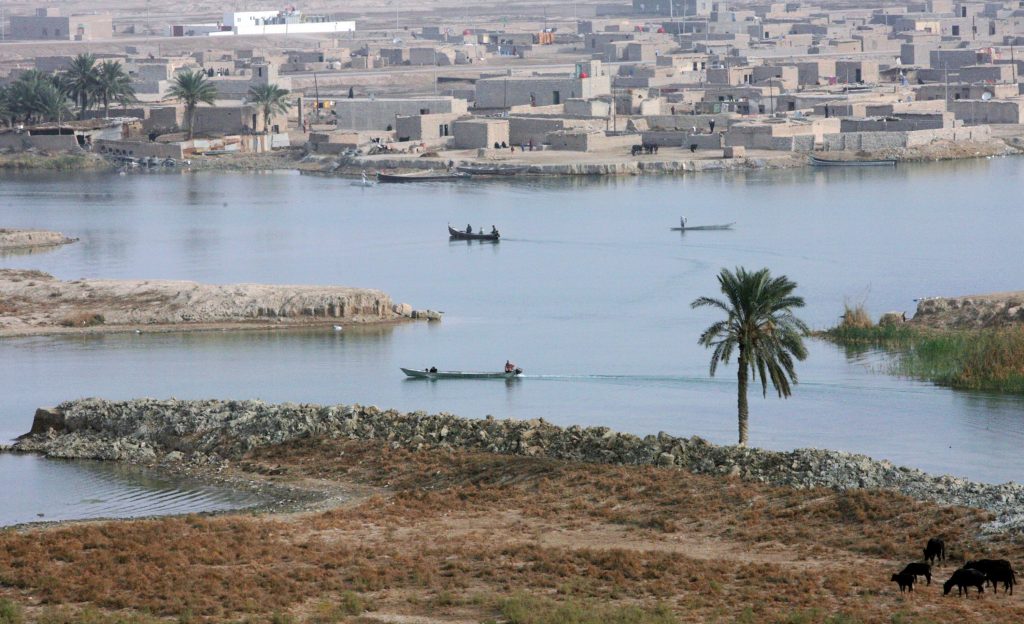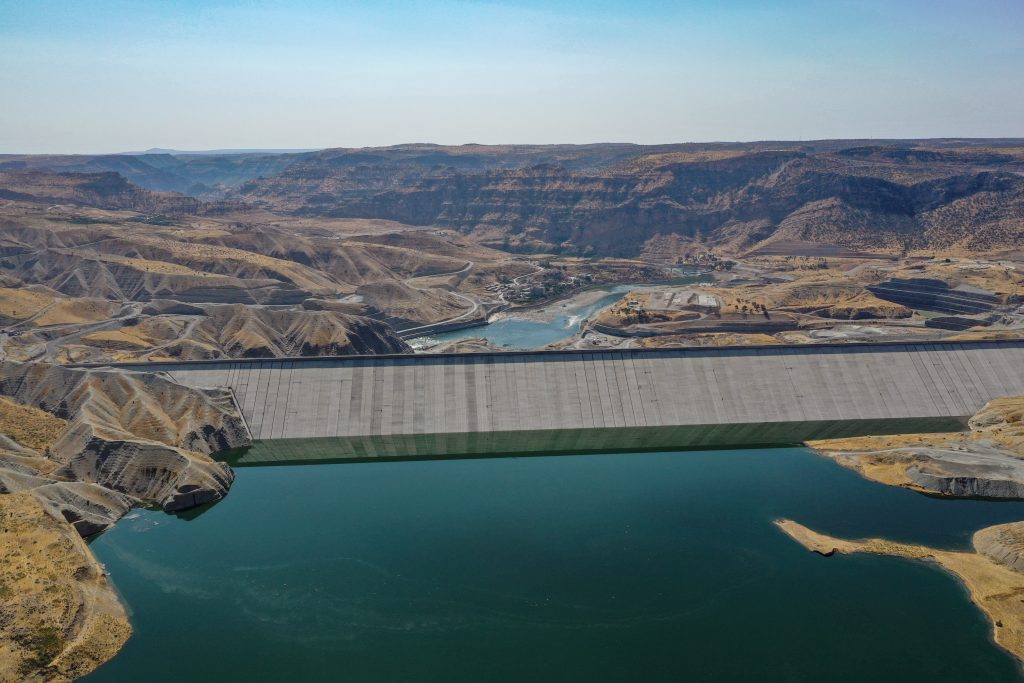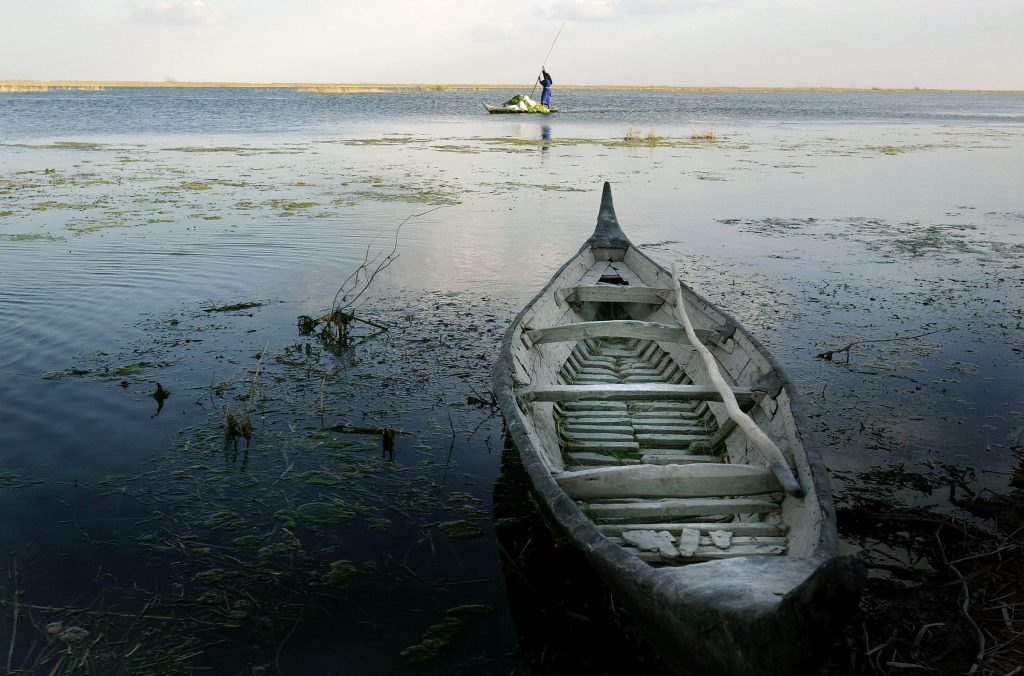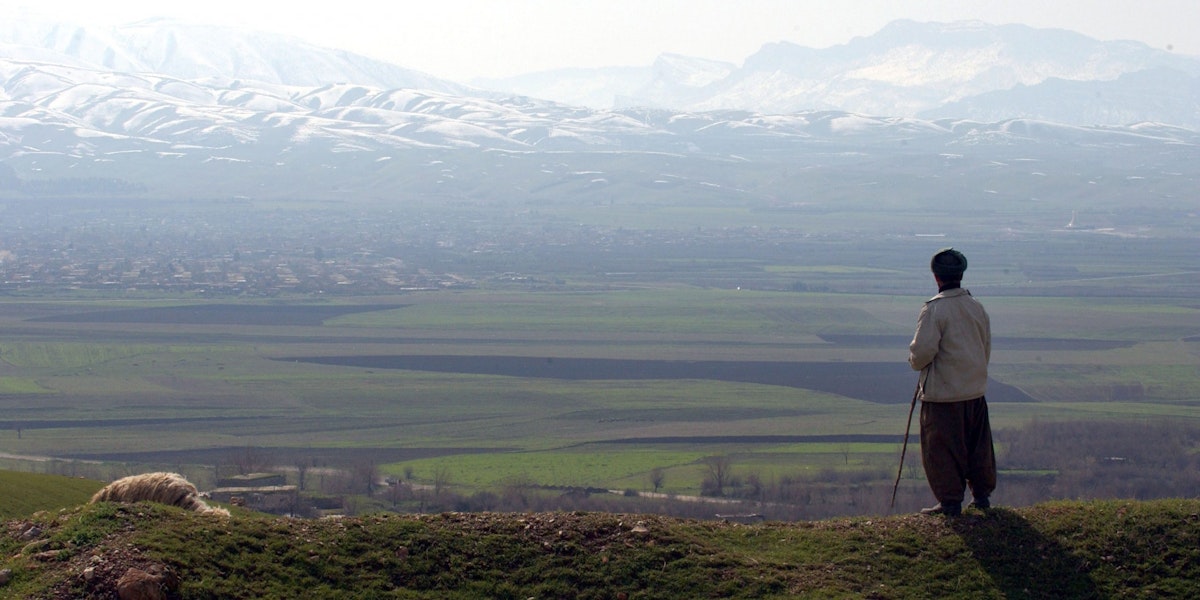The scale of the environmental problems that Iraq faces is so enormous that it can easily trigger a sense of paralysis, even for seasoned analysts. And that is even before we consider the added negative effects of climate change.
Iraq is getting hotter, and the rains and snowfall that feed its great rivers are becoming more unpredictable. As the oceans rise because of polar ice cap melt and ocean temperature increases, the salt water of the Gulf is migrating upstream, invading fertile agricultural areas. Deforestation, desertification, and unsustainable agricultural practices are also a worry. Many countries in the world are experiencing such problems in 2020. But in Iraq, these issues are poisonously networked with a variety of other problems that complicate and amplify the impacts of climate change and environmental degradation.
There is, for one, the instability and poor governance in Iraq that is the result of decades of war and dictatorship.
Then, there is the weakness of the Iraqi economy. Low oil prices have deeply hurt the country’s finances, and the pocketbooks of ordinary citizens. This has exposed more systemic problems in the country’s economy, such as a lack of competitiveness. And Iraqis who are struggling to pay this month’s bills are hardly inclined to worry about large-scale, longer-term problems like climate change.
Finally, the animosity between regional countries in the area has forced Iraq to address its problems in relative isolation from its neighbors—a method that is simply inadequate in the face of major transboundary problems.
Try to solve any one of the above problems, and you inevitably run up against the others. Yet doing nothing is not an option. It is time for solutions that venture far outside the box of standard thinking. Iraq and the Middle East are entering a new environmental era that needs a new type of policy-making: one that reaches across the old fault lines of mistrust and conflict, and dares to break through old assumptions. To thrive and evade the downward spiral in standards of living that would result from the status quo approach, Iraq needs to embrace big ideas and regional cooperation—in a way that it has never done in recent history.
The proposals in this brief report are for projects and policies that will test the limits of what is currently feasible. Some are achievable, with the right work, in the near future. Others will require some type of a thaw in regional relations, the resolution of other problems first, or a catastrophic event that would force the hand of the regional political elite. In general, however, these proposals are meant to chart a path not just toward solving specific problems in Iraq today, but to a new type of problem-solving.
These proposals are meant to chart a path not just toward solving specific problems in Iraq today, but to a new type of problem-solving.
Iraq’s impending environmental catastrophe calls for nothing less. And great advances can arise from great crises. For Iraq and its neighbors—not to mention the European Union, the United States, and the Western world in general—the imperative to innovate and transcend old disputes has never been stronger.
A Toxic Brew of Problems
The facets of Iraq’s environmental crisis cover nearly every corner of policy and development planning.
As in other parts of the region, water is one of the biggest concerns. Part of the problem is population pressure—Iraq is growing at 2.25 percent per year, more than twice the rate of the world generally.1 It is expected that the population, currently 40 million, will be 50 million by 2030 and over 70 million by 2050.2 Two mighty rivers transect Iraq. Those rivers cradled the world’s most ancient civilizations, but they have never before been asked to support so many people.
Poor and antiquated water management within Iraq has further squeezed its hydraulic resources. Historically, and still today, much farming in the south of Iraq has been based on Sumerian flood irrigation methods that have remained essentially unchanged for millennia.3 However, the floods that used to heal the land by removing accumulated salt and depositing new layers of silt and clay are no longer occurring, because dams upstream (including in Turkey and Iran) have changed and diminished the hydro pulse of the Tigris and Euphrates. Further, the farms north of Baghdad that used to be irrigated by rainfall are now being flood-irrigated using pumps. Such flood irrigation methods generate salty drainage water loaded with pesticides and fertilizers, which go on to harm farms downstream and negatively affect ecosystems.

Evaporation is another issue that plagues Iraq’s water supply. Iraq’s management of water resources is based on a philosophy of flood management, with reservoirs and dams built essentially to protect large cities from flooding; these reservoirs also store water in the winter and spring for use in the summer. But reservoirs, with their vast surface areas, are uniquely susceptible to evaporation, especially in hot, dry Iraqi summers. As a result, Iraq annually loses more than 10 billion cubic meters of water to evaporation.
Much of the existing Iraqi hydraulic infrastructure is deteriorating or obsolete. The Mosul Dam, as noted by the U.S. Army Corps of Engineers, is the most dangerous dam in the world due to inherent problems in its foundation, which is built on bedrock containing gypsum, a mineral that dissolves when hydrated.4 The evaporation and percolation losses from this dam alone are about 1 billion cubic meters annually.
Iraqi policy also contributes to the water shortage. The government subsidizes thirsty crops such as maize and wheat. Farmers have little incentive to take a more long-term view on water management, since the subsidies essentially make wastage profitable for them.5
It should also be noted that due to the expected rise of sea levels, the Gulf salt wedge is expected to migrate up the Shatt al-Arab (the river created by the confluence of the Tigris and Euphrates), and some models actually show seawater penetration into the marshes. Historic cities like Basra could be flooded with rising sea levels. Decreased flows in the Euphrates will quicken the advance of salt water. Iranian cities in the lower Euphrates Basin will also suffer from this problem.
The extent of the water problem stretches far beyond Iraq’s borders. Climate change, of course, is heedless of political boundaries.
The extent of the water problem stretches far beyond Iraq’s borders. Climate change, of course, is heedless of political boundaries. Turkish and Iranian sources indicate that snowpack and rain have diminished—though like everything in nature, rain and snowfall are cyclical, and if anything there are now more extreme events.
As a downstream country, Iraq is also at the mercy of its headwaters neighbors, who have their own less-than-perfect water policies. Iran is going ahead with a water diversion project from the source of the lower Zab river (aided by the United Nations Development Programme) to feed water into the diminishing Lake Urmia, without heeding the negative effects of the diversion on Iraq. The project is actually in violation of an important 1974 Iran–Iraq agreement on water and land disputes—an ironic fact, considering that Iran insists that Iraq conform to the agreement with respect to the Shatt al-Arab.6 Further, Iran has built numerous dams on the Karkheh and Karun Rivers and even diverted the path of the latter, in violation of the same 1974 treaty.
Turkey also has contentious projects. In June 2019, Turkey started filling the newly completed Ilisu Dam, built on the headwaters of the Tigris. The Ilisu Dam has a reservoir capacity of more than 10.4 billion cubic meters, and it is expected that this will take two years to fill (by the middle of 2021).7 Due to the higher-than-average water yield in the winter of 2019–20, there may be enough water in Iraq’s Mosul Dam reservoir to make up for the loss of water as a result of the filling of Ilisu. However, long-term trends suggest that the water released from Ilisu will be barely enough to cover Iraq’s current needs, let alone those of the future. Turkey has plans for additional dams as well as water diversion projects from the Tigris to increase its irrigated agricultural areas, which will place further stress on Iraq.

These projects bedevil Iraq’s water planners, as there is an ever-present risk that the country’s spigots could simply be cut off.8 However, upstream neighbors’ water infrastructure need not be a liability if there is cooperation, as explained below.
An Iraqi government project, the Strategy for Water and Land Resources in Iraq (SWLRI), establishes the country’s strategy for water resources management between 2015 and 2035. The SWLRI was a culmination of three years of work by international and Iraqi experts who collected, collated, and analyzed both new and historic data; the experts also participated in workshops that included a range of stakeholders, including the oil industry, the electricity sector, transportation, agriculture, and municipalities. The study predicted a deficit of 11 billion cubic meters of water by 2035 (the gap between supply and demand) if no solutions are implemented.9 The SWLRI also recommended policy changes and projects that would reduce the deficits by implementing solutions such as modernizing irrigation techniques and water recovery and reuse. However, Iraq has not yet implemented any of the recommended projects or policy changes. Further, even if all the projects are implemented, there will likely still be a water deficit, and the deficit will be larger if more headwaters are diverted by neighboring countries.
Iraq needs more systemic solutions—and those solutions will need an economic angle that improves government finances and encourages more investment in the country.
Iraq’s faltering economy has limited the country’s options for addressing these problems. The International Monetary Fund projects that the economy will shrink 12 percent in 2020.10 The near-term cause for the economic weakness is declining global oil prices, but the reality is that this price drop has, yet again, exposed the lack of diversity and competitiveness of Iraq’s other sectors. Further, unlike some other Gulf countries or Israel, Iraq cannot solve its water problems with desalination plants, since the major user of water in the country is agriculture, for which expensive desalinated water is not economical. Iraq needs more systemic solutions—and those solutions will need an economic angle that improves government finances and encourages more investment in the country.
Water scarcity is far from the only environmental issue in Iraq, though it may be the problem with the most direct connection to Iraqis’ livelihoods. Deforestation of the mountains of the Kurdish region has been arrested, and the Kurdistan Regional Government is encouraging reforestation (though the pace of its efforts could be enhanced). The survival of Iraq’s unique ecosystems is another concern, especially that of its marshes, which Saddam Hussein all but destroyed. (My nongovernmental organization, Nature Iraq, has been working to restore those marshes since 2003.)11 Nature is made of complex systems, and as ecological scientists well understand, protecting biodiversity and ecosystems is essential to long-term balance. Solutions to Iraq’s water scarcity must also incorporate more generalized environmental protections.

Other infrastructure problems create additional pressures. The inadequacy of the electricity grid is one of the biggest, and is especially in need of fixing, as air conditioning is becoming an essential utility in warming cities such as Baghdad, which suffered from severe record temperatures well over 50 Celsius this summer. Overall, Iraq is 2.3 degrees Celsius warmer than it was in the nineteenth century.12 Another problem is water delivery and sanitation. Basra, for example, has had critical problems with sanitation. In 2018, dirty water sent 118,000 people to the hospital in that city, and led to major protests.13
The risks if Iraq and the region fail to mitigate these crises could not be clearer. Farmers will abandon the countryside en masse for crowded cities or other countries. Similar migration occurred in Syria in the early stages of that country’s drought in 2006–9; some analysts say that this contributed to the outbreak of the civil war. Compounded with Iraq’s economic problems, such migration and privation could increase tensions in an already unstable region.
Immediately Achievable Cooperation
The magnitude and complexity of Iraq’s water crisis, including its connectedness to neighboring countries, calls for innovative and cooperative solutions that reach across borders just as surely as the problems they address. An effective package of measures will be a combination of short-term projects addressing the immediate problems, and long-term strategic projects that can convert the problems into opportunities for regional cooperation and economic integration built on the backbone of water resources management.
The short-term solutions must focus on reducing pollution of the water and increasing the efficiency of water usage. Most of these projects are described in the SWLRI. The Iraqi government needs help finding funding or investors for these projects. However, the list of projects must be reprioritized and updated given that five years have already been lost since the SWLRI published its findings. The study found that, if none of its recommendations were implemented in a timely manner, the size of Iraq’s water deficit would be too large to address without losing farmlands and, relatedly, displacing farmers. The United States, in cooperation with the European Union, should convene the panels that created the SWLRI’s list of recommendations, and help Iraq decide on the prioritization. It should also incentivize American investors who may be interested in the projects, or help the Iraqi government in providing sovereign guarantees (assurances about the Iraqi government’s role) that would satisfy investors that their money and rights are protected.
In the longer term, however, solutions will need to look outside of Iraq—and outside of current diplomatic limitations. Policymakers must be able to imagine an improved diplomatic landscape in the Middle East, and work toward it. Part of that planning is the adoption of mutually beneficial ideas that make plain the benefits of cooperation.
Following is a set of ideas that could eventually lead to the shared management of water and energy resources, as well as regional and international trade routes. The intention is that these ideas will lead to economic integration that would in itself promote stability in a strategic but volatile region.
- Iraq can strike a symbiotic deal with Turkey to utilize portions of its northern neighbor’s water infrastructure. The reservoir water of Iraq’s imperiled Mosul Dam could be stored in Turkish dams with an agreement negotiated to guarantee not only mutually advantageous operational rules for the Turkish dams on the Tigris river, but also cooperation securing water and energy for all. Storing water in the Ilisu Dam reservoir means reducing the losses and converting more of the river to usable water. Furthermore, it would allow Iraqi engineers to work on the foundations of Mosul Dam to keep it from collapsing. Grouting of the soils under the dam should become much easier when the hydraulic pressure from the reservoir is removed.This solution can also help with the aforementioned evaporation. At least two-thirds of the currently evaporated water can be saved by storing the water in Turkey (before it is released from Turkish dams), where evaporation rates are much lower (due to higher altitudes and deeper reservoirs with smaller lake surfaces). The water saved from evaporation can be used by Iraq to fill the gap of more than 11 billion cubic meters of water described by the SWLRI. If Iraq does not use that water in any given year, it can be viewed as credits that Baghdad could ask for in years of drought.
Ankara, of course, will need a strong incentive for the use of its infrastructure in this way. The leasing rights for storing water in Turkish dams could be paid through reduced prices for gas supplied to Turkey in the short term (ten to twenty years). Iraqi negotiators should be encouraged that, once the gas pipelines reach Istanbul, it is quite possible to extend them into Europe—a particularly compelling conduit for natural gas, which will remain in demand even as world oil use plateaus or decreases. There is an intrinsic geopolitical value of this access to both Iraq and Turkey—even if the world successfully pivots completely away from hydrocarbons, since the future of photovoltaic power generation in Iraq is promising. As the globe leaves the era of hydrocarbons, the right of way for the pipeline can be used to create the connective tissue for combined electric power management (these ideas are elaborated below).
- Iran and Iraq should amend their 1974 agreement that settled water and land disputes between the two countries. They can then cooperate on building a water-regulating structure at Faw across the Shatt al-Arab, to prevent the Gulf salt wedge moving farther north. (There is a similar structure on the Thames River east of London.) The agreement could also allow for periodic releases of water from the Karun and Karkheh Rivers in Iran for environmental reasons—for the health of the marshes and biodiversity of the region. (The rivers emanate from the mountains between Iraq and Iran, along the southerly portion of the two countries’ border.)
- To encourage regional and international cooperation, a public company owned by a consortium that includes Iraq should be created to own and operate the pipelines that would connect the gas fields of Iraq to Europe and, eventually, the electricity network connecting the power generators of the region. It may be prudent to include Kuwait, Saudi Arabia, Qatar, Iran, and others, from the beginning, to make them partners with a stake in the success of the venture and the stabilization of Iraq’s political landscape.
- Iraq and Iran should remove subsidies benefiting products that consume a lot of water (such as rice and wheat) and instead encourage modern production and irrigation methods that save water and reduce drainage. Methods such as drip irrigation and hypotonic farming could help to solve the demand problem and reduce the harmful effects of polluted drainage water.
Bigger Ideas for the Longer Term
In addition to the proposals listed above, which are achievable given the right attention, there are other, bigger ideas that would either take more work or require some change in the current context to pursue.
- When there is a rehabilitated Iran that is ready to join the world—for example, by complying with UN resolutions on nuclear energy—Turkey and Iran might consider connecting Lake Van in Turkey to Lake Urmia in Iran as part of the agreement to manage hydroelectricity and the photovoltaic power mentioned above. Lake Urmia is suffering from loss of water as a result of increased demand on its source water. The salinity of the lake has increased over the past few decades from about 85,000 parts per million (ppm) to about 300,000 ppm, and its surface area has shrunk more than 75 percent. Lake Van is 160 kilometers from Lake Urmia, and has a difference of elevation of about 470 meters; it is stable and has a salinity of about 23,000 ppm. There is potential for water from Lake Van to be conveyed to Lake Urmia at a cost of approximately $1.5–2 billion. The electricity generated can be used to pay for the cost over the long term.
- Water from the Euphrates could eventually be exported to the Jordan River Basin, if enough water is saved in the Euphrates Basin through other measures—or if the peace dividends are high enough. The right-of-way of the Iraqi Petroleum Company that once contained a pipeline to export Kirkuk oil to Haifa in British Mandate Palestine (these exports stopped after the creation of Israel in 1948) could be used to construct a pipeline to transfer water from the Euphrates to the Jordan River. Removing water from the list of issues creating tensions between Jordan, Palestine, and Israel—and even Syria—cannot but help the peace process move forward. This is a longer-term idea, but one that should be kept in mind as a possible dividend of better water management for regional security.
A Stronger Iraqi Economy
The environment-focused measures listed above need to be combined with a robust plan for diversifying, developing, and strengthening the Iraqi economy. Just as the Iraqi economy cannot succeed without protecting the environment, environmental and water policy cannot succeed with a broken economy.
One basic issue that Iraq needs to address is its electricity supply. Here too, there are solutions that can boost both the environment and regional integration. A region-wide electric utility company could be created out of a conglomerate of electricity producing units—be they thermal, solar, or hydroelectric—to manage the supply and demand of electricity. This measure could be coupled with the creation of a region-wide company that owns the transmission lines. Given the sun exposure enjoyed in the region, particularly in the south, it is conceivable that this network could also provide Europe with sustainable energy in the next century.
The region-wide conglomerate could benefit from surpluses in other countries. And as with other places in the world, a well-designed larger network can buffer the grid against shocks. The electric grids of Iraq, Iran, Kuwait, and Turkey (and possibly Saudi Arabia) could be connected to facilitate the sharing of excess capacity on production to reduce the overall expenditure of these countries on electricity-generating infrastructure. For example, more than half of the electric generation power of Kuwait is idle for nine months a year. This capital, as expressed in infrastructure, may be used to save Iraq the cost of building new infrastructure and satisfy its demand. It would also decrease blackouts that have suffocated the income of Iraqi households, which pay, on average, $200–$300 per month for services that are constantly interrupted by brownouts. The overall network would also benefit from the geographic range of the region, with its opportunities for photovoltaic energy generation, hydroelectric power in the mountains, and some opportunities for wind power.
Other measures will be needed to lift the dynamism of Iraq’s economy. The World Bank ranks Iraq 172 in the world for ease of doing business, ahead of only Syria, Libya, and Yemen in the Middle East and North Africa.14 Declining oil revenues would not be such a problem in and of themselves if this was improved.
U.S. Interests Require a Stable Iraq
The U.S. Army has identified climate change as one of the most severe threats to U.S. interests. The migration and displacement that will occur because of rising seas and extreme weather will pose a particular risk to security, because they can threaten stability and overwhelm cities.15 These problems are hardly unique to the Middle East, but they are particularly dangerous in Iraq and the region because the preexisting security situation is already so precarious. The beleaguered populations of the Middle East have already had their fill of poor governance. Even the most able policy makers in regional capitals barely have the capacity to manage the many issues already on their plates.
Again, it is time for big and even unorthodox ideas—policies and goals that can completely challenge and change the current paradigms. It is time to put the environment at the center of policy agendas. Iraq must be able to take ownership of the process, but cannot succeed alone. Greater cooperation with the region—and even with erstwhile adversaries—is essential, as is assistance from the international community. And there is reason for hope: the grand problem of climate change can open even grander opportunities for solutions, with benefits that are as self-amplifying as the problems that so urgently need to be tackled.
The United States, too, can convert Iraq’s difficult knot of problems—climate change, environmental degradation, population growth, and a weak economy—into an opportunity to bolster its own interests and national security. The necessary actions are large but achievable: helping to implement the long-term recommendations presented above in a stepwise fashion, promoting regional economic integration on the back of shared regional water management, and boosting the role of the private sector in electricity generation and transmission.
Inaction in the face of the Middle East’s climate challenge will only become more expensive. On the other hand, implementing bold ideas will take courage and energy, but will also reap outsize rewards—for the region and the world.
This report was written with support from the Rockefeller Brothers Fund as part of the TCF initiative “Nature and National Security in the Middle East.”
header photo: In a 2004 photo, a shepherd in Halabja in Iraqi Kurdistan, near the Zagros Mountains, looks out at snowy peaks. Turkish and Iranian sources indicate that the snow and rain that feed Iraq’s rivers have diminished, though more extreme events are also a possibility. Source: Marco Di Lauro/Getty Images
Notes
- “Population Growth (Annual %)—Iraq,” World Bank, https://data.worldbank.org/indicator/SP.POP.GROW?locations=IQ .
- “Projections of Population Growth of Iraq (2030),” Population of the World,
https://www.livepopulation.com/population-projections/iraq-2030.html. - The Sumerian culture was active in Mesopotamia from 4500–1900 B.C.E.
- “Relief and Reconstruction Funded Work at Mosul Dam,” U.S. Office of the Special Inspector General for the Reconstruction of Iraq, 2007, https://apps.dtic.mil/dtic/tr/fulltext/u2/a525294.pdf.
- “Turning the Corner: Sustaining Growth and Creating Opportunities for Iraq’s Youth,” World Bank Iraq Economic Monitor, Fall 2019, http://documents1.worldbank.org/curated/en/848371571505101026/pdf/Iraq-Economic-Monitor-Fall-2019-Turning-the-Corner-Sustaining-Growth-and-Creating-Opportunities-for-Iraq-s-Youth.pdf; “Global Information and Early Warning System,” Food and Agriculture Organization of the United Nations, May 15, 2020, http://www.fao.org/giews/countrybrief/country.jsp?code=IRQ.
- “Government of Japan–UNDP Partnership on Lake Urmia Restoration Enters 7th Phase,” United Nations Development Programme, April 21, 2020, https://www.ir.undp.org/content/iran/en/home/presscenter/articles/2020/Government-of-Japan-UNDP-partnership-on-Lake-Urmia.html.
- “The Ilisu Dam Project,” RiverNet, https://www.rivernet.org/turquie/ilisu.htm; “Climate Change Impacts: The Middle East and Iraq in Focus,” Iraqi Forum for Intellectuals and Academics, October 27, 2018, https://iraqi-forum2014.com/لجنة-الزراعة-و-الري-en/climate-change-impacts-the-middle-east-and-iraq-in-focus/ .
- Campbell Robertson, “Iraq Suffers as the Euphrates Dries Up,” New York Times, July 13, 2009, https://www.nytimes.com/2009/07/14/world/middleeast/14euphrates.html#:~:text=The%20Euphrates%20is%20drying%20up,just%20a%20few%20years%20ago.&text=Along%20the%20river%2C%20rice%20and,have%20turned%20to%20baked%20dirt.
- “Strategy for Water and Land Resources in Iraq (SWLRI),” T-Zero, October 2015, http://t-zero.it/en/portfolio/swlri-strategy-for-water-and-land-resources-in-iraq/.
- “World Economic Outlook Database,” International Monetary Fund, October 2020, https://www.imf.org/en/Publications/WEO/weo-database/2020/October/weo-report?c=433,&s=NGDP_RPCH,&sy=2010&ey=2025&ssm=0&scsm=1&scc=0&ssd=1&ssc=0&sic=0&sort=country&ds=.&br=1.
- “Preserving the Marshlands of Iraq: Nature Iraq,” Atlas of the Future, https://atlasofthefuture.org/project/nature-iraq/.
- Louisa Loveluck and Chris Mooney, “Baghdad’s Record Heat Offers Glimpse of World’s Climate Change Future,” Washington Post, August 12, 2020, https://www.washingtonpost.com/world/2020/08/12/baghdad-iraq-heat-climate-change/?arc404=true.
- “Iraq: Water Crisis in Basra,” Human Rights Watch, July 22, 2019, https://www.hrw.org/news/2019/07/22/iraq-water-crisis-basra#.
- “Ease of Doing Business Rankings,” World Bank, 2020, https://www.doingbusiness.org/en/rankings.
- “Implications of Climate Change for the U.S. Army,” United States Army War College, 2019, https://climateandsecurity.files.wordpress.com/2019/07/implications-of-climate-change-for-us-army_army-war-college_2019.pdf.










